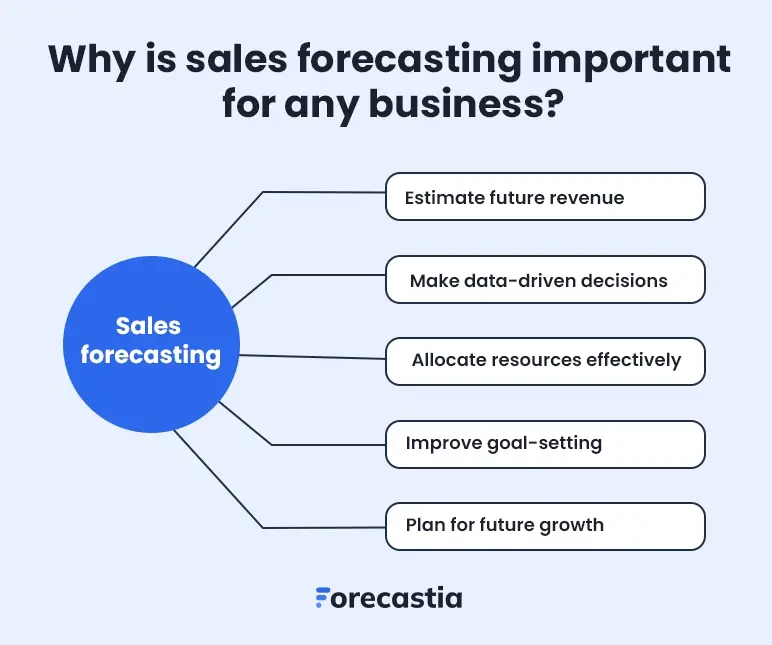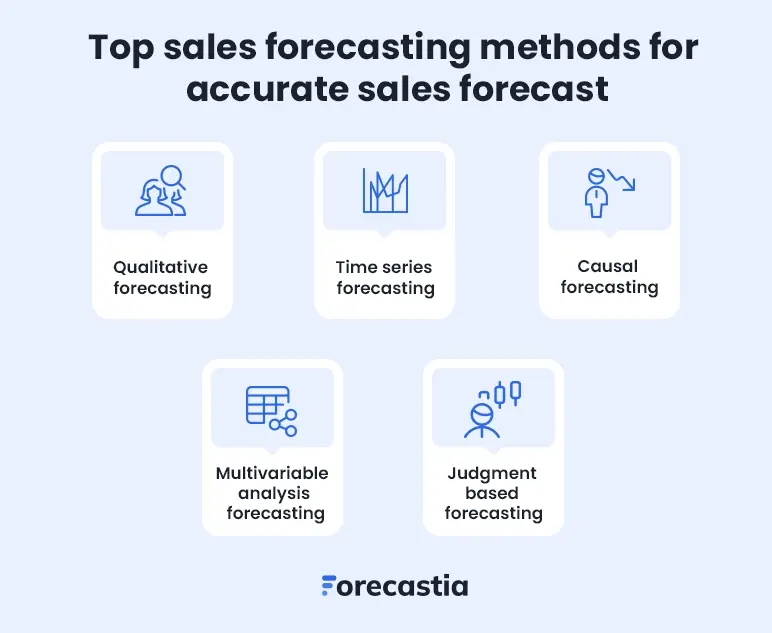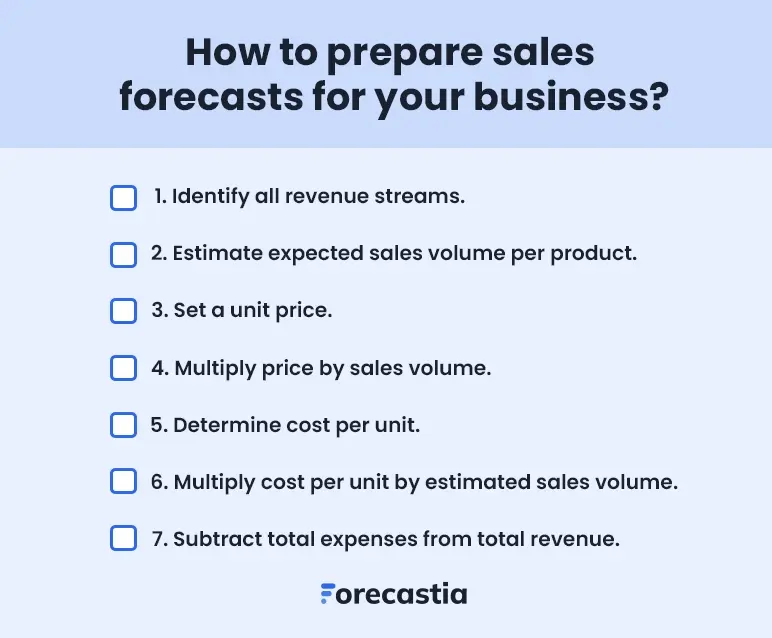Less than 20% of sales organizations have forecast accuracy of 75% or higher.
If you too are struggling to plan your next quarter, unsure how much inventory to order, or worried about unexpected dips in revenue, these are all signs that your business needs better forecasting.
If you don't have any idea how much you will sell next month, how do you plan for inventory, people, or growth? Without a solid sales forecasting process, you risk financial failures that could be prevented.
Clearly, sales forecasting prepares companies for the change in demand, prevents inventory problems, and achieves maximum returns.
But what is sales forecasting really? In this blog, we’ll talk all about the importance of sales forecasting, and the different forecasting methods.
What is sales forecasting?
Sales forecasting is predicting future sales over a given period—weekly, monthly, quarterly, or yearly. It’s derived from historical sales data, demand fluctuations, and external factors like seasonality and market conditions.
For example, a gym has a surge of new members every January. Instead of bringing on additional trainers or purchasing more equipment than they can utilize, they use past patterns to anticipate demand.
With a good sales projection, they can expect and prepare for the surge of fresh individuals, making sure they have enough staff and capacity to cater to them without squandering resources.
These forecasts help sales teams and sales leaders adjust their sales strategy, resource allocation, and sales quotas accordingly.
Why is sales forecasting important for any business?
Ever wondered how some businesses always seem to be prepared for market changes with an accurate sales forecast? Sales forecasting helps them analyze sales data, predict future sales, and optimize resource allocation.
Here’s how:.

1. Estimate future revenue
You need to accurately forecast sales to plan your next steps. A solid sales forecast built on historical data, sales forecasting software, and external trends helps businesses estimate revenue with greater accuracy.
For example, PepsiCo uses past and current sales data to predict demand, keeping its shelves adequately stocked. An organized sales forecast enables businesses to plan marketing expenses and production capacities effectively
2. Make data-driven decisions
Historical sales data can be analyzed to assess conditions in the marketplace and determine if new products should be launched, additional people should be hired, or new markets entered. It eliminates uncertainty if an accurate sales forecast is produced, enabling sound business decisions.
3. Allocate resources effectively
A documented sales process provides for the effective utilization of inventory, labor, and advertising budgets. Businesses using forecasting software can best allocate resources using current data to maximize top-line growth.
4. Improve goal-setting
Setting realistic sales quotas is easier when you have past sales data to back them up. Aligning sales pipeline expectations with future sales performance helps teams meet measurable goals.
5. Plan for future growth
The best companies predict sales correctly to prevent unanticipated downturns. Sales forecasting technology allows companies to project sales trends, see ahead for threats, and find growth opportunities.
Financial vs. sales forecasting
A sales forecast informs you how much you will sell based on historical information and previous performance to forecast future sales. It assists companies in managing inventory, fulfilling sales targets, and marketing campaigns.
Financial forecasting, on the other hand, looks at the entire financial picture. It includes revenue, expenses, and cash flow, using sales forecasts alongside business costs and market data to ensure forecast accuracy.
For example, Apple employs sales forecasting to predict iPhone demand in various markets, while its financial forecast takes into account worldwide economic trends and production costs.
Cash flow vs. sales forecasting
An effective process of forecasting has both cash forecasting and sales forecasting as pillars on which it rests, though targeting different spaces.
Sales forecasting predicts future sales revenue, based on historical data, past performance, and market trends to make reliable forecasts. And cash flow forecasting is concerned with when money actually flows, to ensure that businesses have sufficient liquidity to meet expenses, payroll, and operational costs.
Top sales forecasting methods for accurate sales forecast
Here are the widely used sales forecasting methods for strategic business success.

Qualitative forecasting
If businesses lack past sales data, they use qualitative forecasting to estimate future sales. It’s based on professional opinions, market studies, and industry analysis, thus used in the launch of a new product and expansion into a new market.
Common qualitative forecasting models:
- Test market analysis forecasting: Companies test products in smaller markets before full-scale rollouts.
- Intuitive sales forecasting: Sales reps use experience and market knowledge to estimate revenue.
Time series forecasting
Businesses that rely on historical sales data can use time series forecasting to identify recurring trends and predict future revenue. This method assumes that market cycles repeat over time, helping companies adjust to seasonal fluctuations and demand changes for predicting future sales.
Common time series forecasting models:
- Historical forecasting: Looks at past revenue trends and historical data to estimate future financial performance.
- Length of sales cycle forecasting: Uses deal closure timelines to forecast future sales and expected revenue.
- Seasonality analysis: Helps businesses anticipate peak sales periods, such as holidays or back-to-school seasons.
Retailers, particularly big-box retailers such as Walmart, experience enormous seasonal fluctuations in demand, especially during peak shopping events such as Black Friday, Cyber Monday, and Christmas. Because consumer consumption patterns change drastically during these times, Walmart employs time-series forecasting to prepare.
Causal forecasting
Causal forecasting extends beyond mere historical sales information by adding external market influences such as price changes, economic patterns, and competition. It helps firms sharpen their sales forecasting technique for enhanced strategic planning.
Common causal forecasting models:
- Pipeline Forecasting: Uses deal progress tracking to estimate upcoming revenue.
- Opportunity stage forecasting: Predicts future sales and revenue based on how far deals have moved through the pipeline.
- Lead-driven forecasting: Evaluates which lead sources are most likely to convert into sales.
Multivariable analysis forecasting
Businesses with complex sales cycles require forecasting methods that account for multiple factors like:
- Customer behavior (reviews, loyalty)
- Economic conditions (inflations, recession)
- Marketing efforts (promotions, ads)
- Industry trends (sustainability, holidays)
Multivariable analysis forecasting integrates all these elements, often using AI-driven predictive analytics to generate accurate sales forecasts.
Judgment-based forecasting
This approach depends on human expertise and industry experience instead of hard data. When historical trends are unreliable, experts analyze market shifts and potential disruptions to make realistic sales forecasts.
Common judgment-based forecasting models:
- Delphi method: Experts refine predictions through a structured process.
- Scenario planning: Businesses evaluate multiple financial scenarios to predict future sales.
How to choose the right sales forecasting method?
All companies require a sales forecasting approach that matches their sales process and market conditions. But how does one select the best one for an accurate forecast?
Check your available market data
- Got historical sales data? Use historical forecasting or time series forecasting to create an accurate sales forecast.
- No past sales data? Qualitative forecasting relies on expert opinions and market trends to estimate future sales.
Analyze market trends & outside factors
- Is your business impacted by competitor pricing, economic conditions, or supply chain disruptions? You may need causal forecasting for accurate forecasts.
- Do you need to track customer behavior and multiple variables? Multivariable analysis forecasting improves sales performance predictions.
Align your forecast with your sales process
- If your business has a complex sales pipeline, using length of sales cycle forecasting can help you track predicting sales trends.
- For seasonal demand fluctuations, seasonality analysis ensures accurate sales forecasts.
Automating the forecasting process improves efficiency. Forecasting software provides current data and helps sales organizations and sales representatives improve predictions.
Picking the right sales forecasting method is the key to an accurate sales forecast. Get it right the first time and predict your future sales right!
How to prepare sales forecasts for your business?
Salesforce says that top-performing sales teams are 1.5 times more likely to make forecasts based on data-driven insights.
Accurate sales projections help businesses plan, attract investors, and secure funding. A well-structured projection shows revenue, expenses, and expected profit.

Follow these steps to create one:
- Identify all revenue streams. Break them down by product or service.
- Estimate expected sales volume per product. Use historical sales data or market research.
- Set a unit price. Ensure pricing reflects market trends and customer demand.
- Multiply price by sales volume. This gives your projected revenue.
- Determine cost per unit. Factor in materials, labor, and operational expenses.
- Multiply the cost per unit by estimated sales volume. This provides total expenses.
- Subtract total expenses from total revenue. The remaining amount is projected profit.
Each revenue stream should be analyzed separately for accuracy. Businesses should also adjust projections periodically based on market trends, economic conditions, and business growth.
Sales projections help businesses manage cash flow, identify funding needs, and make data-backed financial decisions. Investors and lenders will want to see realistic revenue estimates backed by data before approving funding.
Sales forecasting mistakes to avoid
A case study of sales forecasting with machine learning found that more than 60% of sales leaders consider their firm's forecasting to be inaccurate because they base it on past trends without considering outside factors such as economic downturns.
An inaccurate sales forecast can cost your business money and time. If your salespeople aren’t meeting their sales targets, perhaps it’s time to examine sales data and steer clear of these typical forecasting errors:
- Overdependence on historical sales data: Historical records do not always mean future performance, particularly in ever-changing industries where the market fluctuates now and then.
- Underestimating seasonality: Not recognizing seasonal trends can result in inventory mismanagement and budget misallocations.
- Overcomplicating the forecasting model: While documented sales processes improve accuracy, overly complex models may not align with sales team expectations.
- Failing to adjust for outside factors: A rigid forecast without contingency plans can create serious financial vulnerabilities.
- Infrequent updates to forecasts: Businesses that set a one-time forecast and never adjust it risk making decisions based on outdated assumptions.
- Neglecting cash flow forecasting: Profitability doesn’t equal liquidity. Overlooking short-term liquidity forecasting can result in funding gaps and late payments.
- Ignoring input from the sales team: Financial forecasts that ignore real-world sales pipeline data may not reflect actual customer demand and market conditions.
- Failing to incorporate production capacity: Inventory and staffing must align with expected sales revenue to avoid inefficiencies.
- Not using forecasting software: Manual calculations increase human errors. Modern sales forecasting technology improves accuracy and agility.
Preparing sales forecasts using AI
Sales forecasting is complicated, especially when you’re managing historical data, multiple sales variables, and ever-changing pipeline metrics. One small mistake can throw off your entire forecast.
With financial forecasting solutions such as Forecastia, there’s no second-guessing your numbers. This AI-powered sales forecasting software automates the forecasting process, bringing you real-time figures from your pipeline of sales, and providing the right forecasts.
Instead of spending hours on spreadsheets, your sales team can focus on closing deals while Forecastia handles the data crunching.
Frequently Asked Questions
What are the different types of sales forecasting?
Some sales forecasting types include historical forecasting, opportunity stage analysis, multivariable analysis, intuitive forecasting, pipeline forecasting, lead value estimation, regression analysis, and time series analysis.
What are the most common methods used in sales forecasting?
Popular sales forecasting methods include regression analysis, time series analysis, lead-driven forecasting, and intuitive forecasting. Businesses also rely on qualitative approaches, such as expert insights and market research, depending on data availability and specific forecasting requirements.
What are the key components of a sales forecast?
Sales forecasts include historical sales data, industry trends, competitor insights, seasonal variations, customer behavior, economic conditions, pricing strategies, promotional efforts, and expected market shifts. Essentially, it incorporates any relevant data that helps estimate future sales volume and revenue within a given period.
What are some common mistakes to avoid in sales forecasting?
Common sales forecasting mistakes include:
- Relying too much on historical trends
- Ignoring external factors like economic conditions, competition, and industry trends
- Overlooking seasonality
- Not using forecasting software
- Using one forecasting model for all products and markets
- Not updating forecasts regularly as markets change
- Underestimating risks
- Ignoring the sales team’s input

